Emerging Technologies and Innovation: Cloud Computing Report
VerifiedAdded on 2023/06/04
|9
|2118
|217
Report
AI Summary
This report provides a comprehensive analysis of cloud computing and cloud migration, focusing on its impact on business operations and IT infrastructure. The report begins by defining cloud computing and its advantages, such as reduced operational costs, increased efficiency, and scalability. It then explores the process of cloud migration, highlighting the importance of data security and encryption to protect sensitive information during the transition. The report discusses the benefits of cloud migration, including reduced server traffic, improved IT process effectiveness, and enhanced integration across departments. However, it also acknowledges the limitations and risks, such as potential security vulnerabilities, compliance requirements, and compatibility issues with existing systems. The report references various academic sources to support its findings, offering a balanced view of the technology's potential and challenges. It concludes by emphasizing the ongoing evolution of cloud computing and the need for continuous research to address emerging risks and opportunities. This report is a project closure for a student assignment, summarizing the findings and conclusions of a research project on cloud computing and cloud migration, including references to relevant literature and a discussion of the current state of cloud technology.
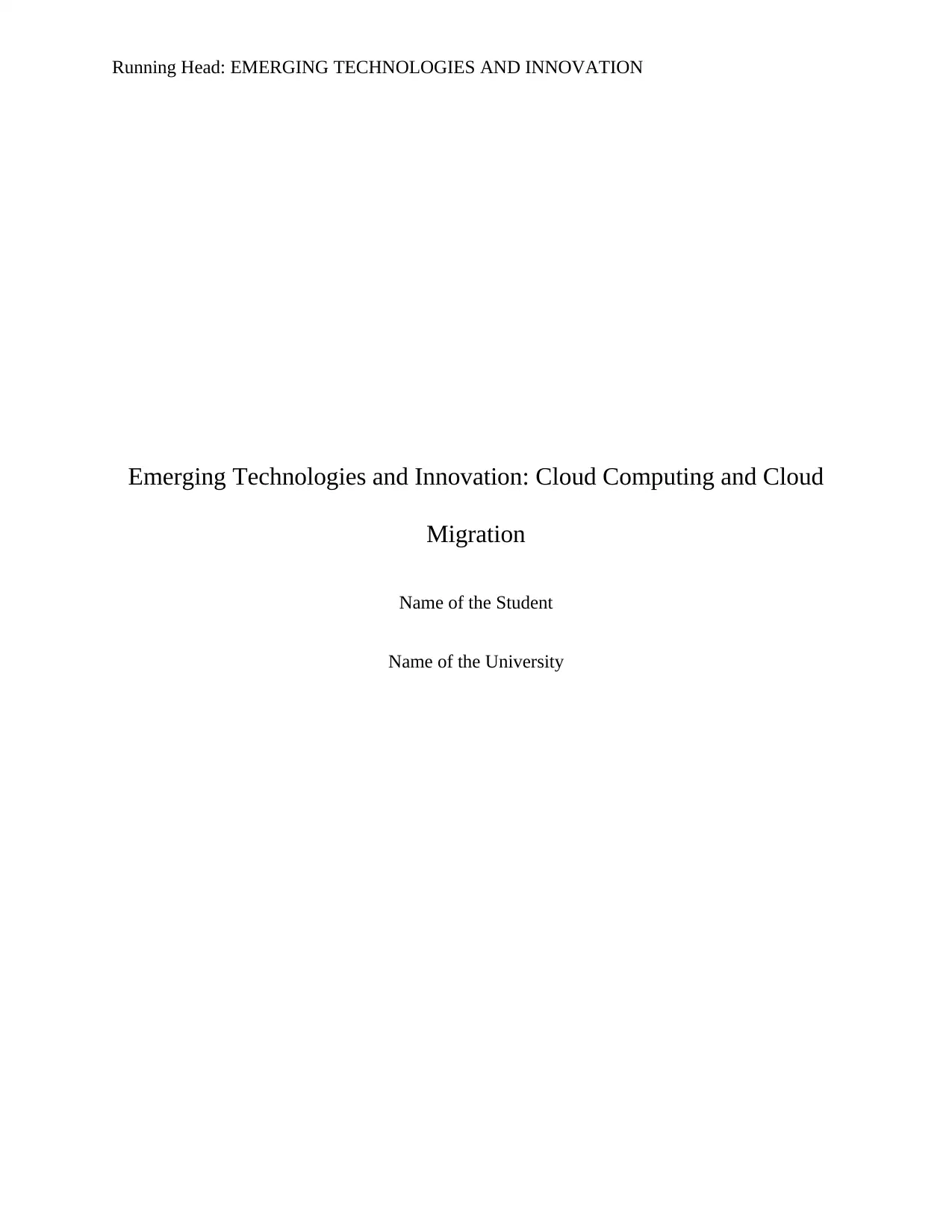
Running Head: EMERGING TECHNOLOGIES AND INNOVATION
Emerging Technologies and Innovation: Cloud Computing and Cloud
Migration
Name of the Student
Name of the University
Emerging Technologies and Innovation: Cloud Computing and Cloud
Migration
Name of the Student
Name of the University
Paraphrase This Document
Need a fresh take? Get an instant paraphrase of this document with our AI Paraphraser
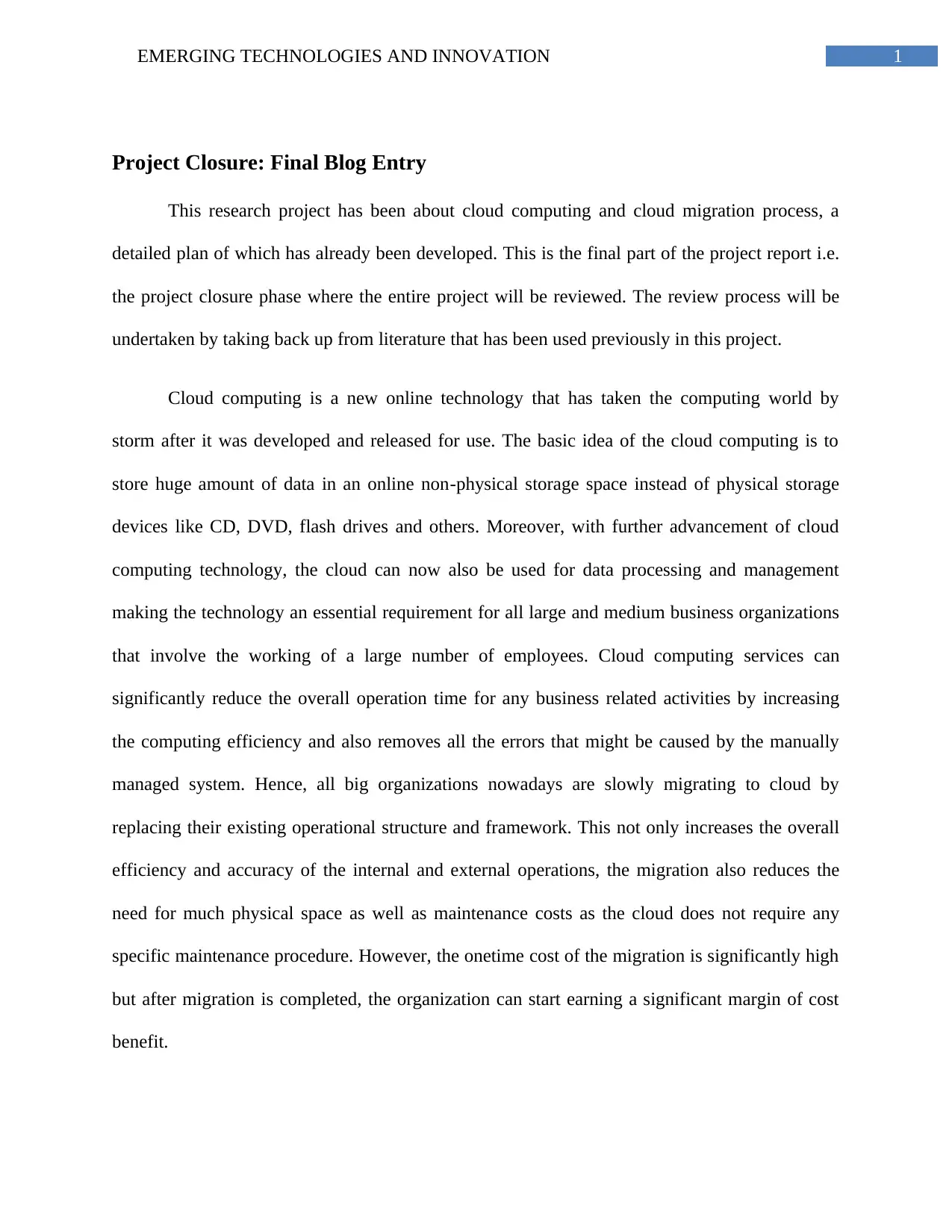
1EMERGING TECHNOLOGIES AND INNOVATION
Project Closure: Final Blog Entry
This research project has been about cloud computing and cloud migration process, a
detailed plan of which has already been developed. This is the final part of the project report i.e.
the project closure phase where the entire project will be reviewed. The review process will be
undertaken by taking back up from literature that has been used previously in this project.
Cloud computing is a new online technology that has taken the computing world by
storm after it was developed and released for use. The basic idea of the cloud computing is to
store huge amount of data in an online non-physical storage space instead of physical storage
devices like CD, DVD, flash drives and others. Moreover, with further advancement of cloud
computing technology, the cloud can now also be used for data processing and management
making the technology an essential requirement for all large and medium business organizations
that involve the working of a large number of employees. Cloud computing services can
significantly reduce the overall operation time for any business related activities by increasing
the computing efficiency and also removes all the errors that might be caused by the manually
managed system. Hence, all big organizations nowadays are slowly migrating to cloud by
replacing their existing operational structure and framework. This not only increases the overall
efficiency and accuracy of the internal and external operations, the migration also reduces the
need for much physical space as well as maintenance costs as the cloud does not require any
specific maintenance procedure. However, the onetime cost of the migration is significantly high
but after migration is completed, the organization can start earning a significant margin of cost
benefit.
Project Closure: Final Blog Entry
This research project has been about cloud computing and cloud migration process, a
detailed plan of which has already been developed. This is the final part of the project report i.e.
the project closure phase where the entire project will be reviewed. The review process will be
undertaken by taking back up from literature that has been used previously in this project.
Cloud computing is a new online technology that has taken the computing world by
storm after it was developed and released for use. The basic idea of the cloud computing is to
store huge amount of data in an online non-physical storage space instead of physical storage
devices like CD, DVD, flash drives and others. Moreover, with further advancement of cloud
computing technology, the cloud can now also be used for data processing and management
making the technology an essential requirement for all large and medium business organizations
that involve the working of a large number of employees. Cloud computing services can
significantly reduce the overall operation time for any business related activities by increasing
the computing efficiency and also removes all the errors that might be caused by the manually
managed system. Hence, all big organizations nowadays are slowly migrating to cloud by
replacing their existing operational structure and framework. This not only increases the overall
efficiency and accuracy of the internal and external operations, the migration also reduces the
need for much physical space as well as maintenance costs as the cloud does not require any
specific maintenance procedure. However, the onetime cost of the migration is significantly high
but after migration is completed, the organization can start earning a significant margin of cost
benefit.
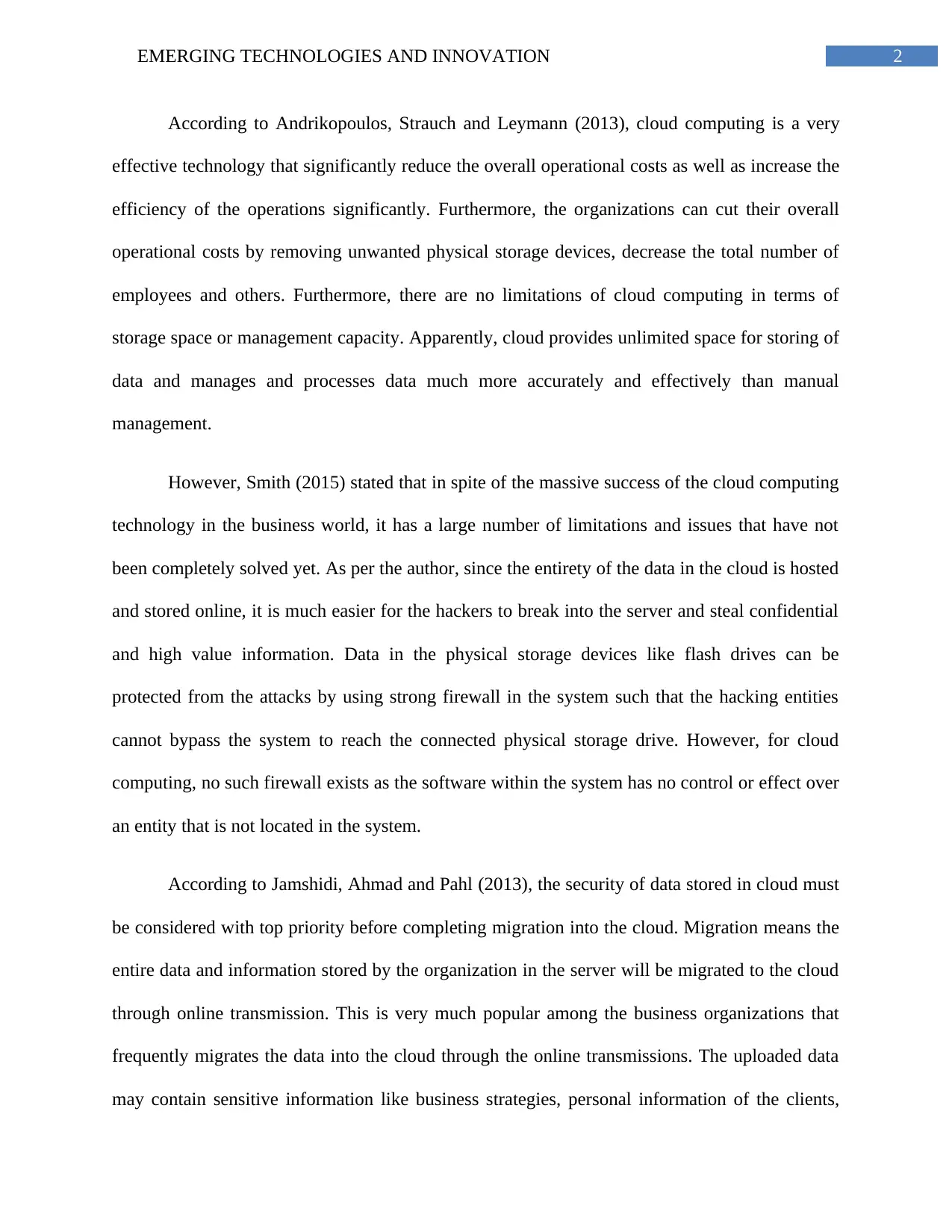
2EMERGING TECHNOLOGIES AND INNOVATION
According to Andrikopoulos, Strauch and Leymann (2013), cloud computing is a very
effective technology that significantly reduce the overall operational costs as well as increase the
efficiency of the operations significantly. Furthermore, the organizations can cut their overall
operational costs by removing unwanted physical storage devices, decrease the total number of
employees and others. Furthermore, there are no limitations of cloud computing in terms of
storage space or management capacity. Apparently, cloud provides unlimited space for storing of
data and manages and processes data much more accurately and effectively than manual
management.
However, Smith (2015) stated that in spite of the massive success of the cloud computing
technology in the business world, it has a large number of limitations and issues that have not
been completely solved yet. As per the author, since the entirety of the data in the cloud is hosted
and stored online, it is much easier for the hackers to break into the server and steal confidential
and high value information. Data in the physical storage devices like flash drives can be
protected from the attacks by using strong firewall in the system such that the hacking entities
cannot bypass the system to reach the connected physical storage drive. However, for cloud
computing, no such firewall exists as the software within the system has no control or effect over
an entity that is not located in the system.
According to Jamshidi, Ahmad and Pahl (2013), the security of data stored in cloud must
be considered with top priority before completing migration into the cloud. Migration means the
entire data and information stored by the organization in the server will be migrated to the cloud
through online transmission. This is very much popular among the business organizations that
frequently migrates the data into the cloud through the online transmissions. The uploaded data
may contain sensitive information like business strategies, personal information of the clients,
According to Andrikopoulos, Strauch and Leymann (2013), cloud computing is a very
effective technology that significantly reduce the overall operational costs as well as increase the
efficiency of the operations significantly. Furthermore, the organizations can cut their overall
operational costs by removing unwanted physical storage devices, decrease the total number of
employees and others. Furthermore, there are no limitations of cloud computing in terms of
storage space or management capacity. Apparently, cloud provides unlimited space for storing of
data and manages and processes data much more accurately and effectively than manual
management.
However, Smith (2015) stated that in spite of the massive success of the cloud computing
technology in the business world, it has a large number of limitations and issues that have not
been completely solved yet. As per the author, since the entirety of the data in the cloud is hosted
and stored online, it is much easier for the hackers to break into the server and steal confidential
and high value information. Data in the physical storage devices like flash drives can be
protected from the attacks by using strong firewall in the system such that the hacking entities
cannot bypass the system to reach the connected physical storage drive. However, for cloud
computing, no such firewall exists as the software within the system has no control or effect over
an entity that is not located in the system.
According to Jamshidi, Ahmad and Pahl (2013), the security of data stored in cloud must
be considered with top priority before completing migration into the cloud. Migration means the
entire data and information stored by the organization in the server will be migrated to the cloud
through online transmission. This is very much popular among the business organizations that
frequently migrates the data into the cloud through the online transmissions. The uploaded data
may contain sensitive information like business strategies, personal information of the clients,
⊘ This is a preview!⊘
Do you want full access?
Subscribe today to unlock all pages.

Trusted by 1+ million students worldwide
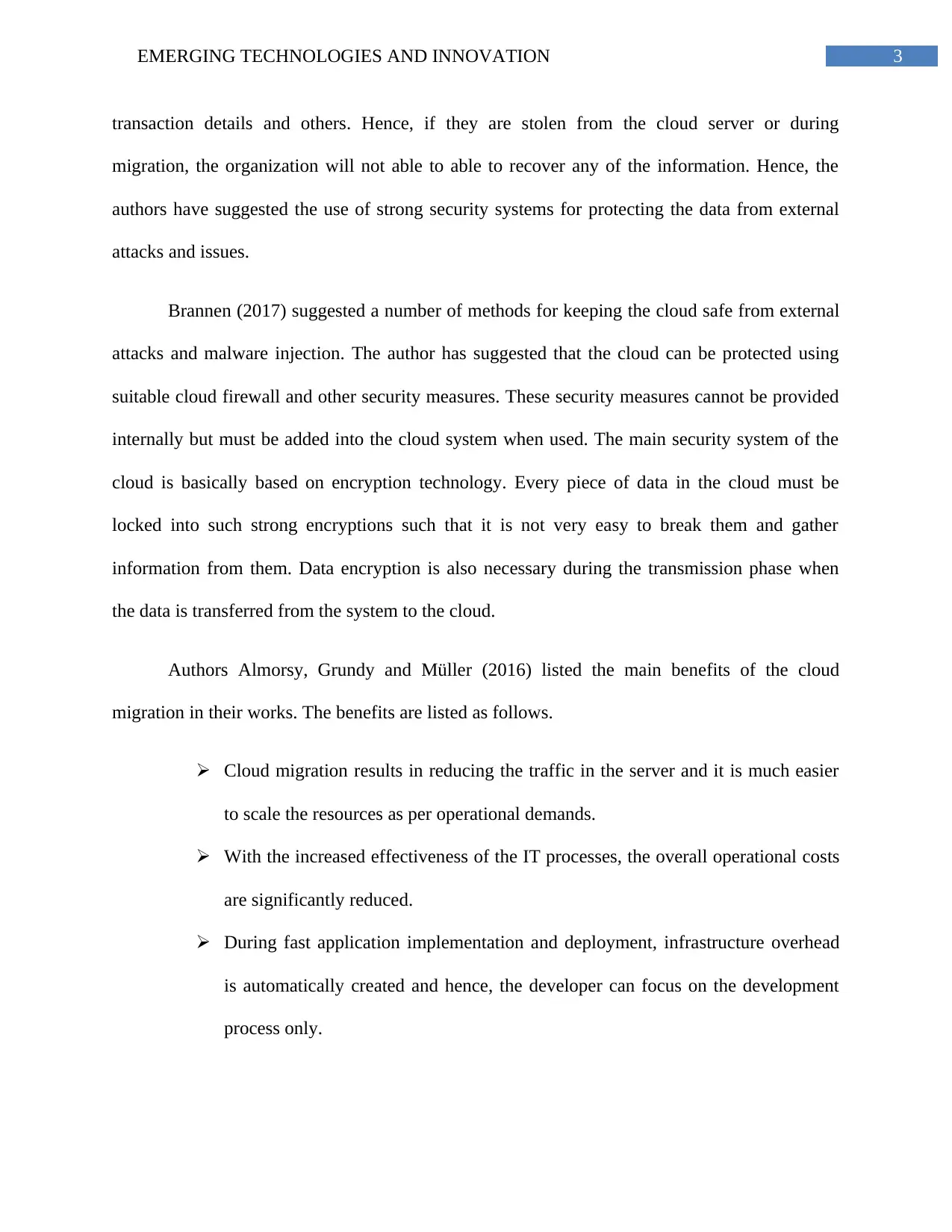
3EMERGING TECHNOLOGIES AND INNOVATION
transaction details and others. Hence, if they are stolen from the cloud server or during
migration, the organization will not able to able to recover any of the information. Hence, the
authors have suggested the use of strong security systems for protecting the data from external
attacks and issues.
Brannen (2017) suggested a number of methods for keeping the cloud safe from external
attacks and malware injection. The author has suggested that the cloud can be protected using
suitable cloud firewall and other security measures. These security measures cannot be provided
internally but must be added into the cloud system when used. The main security system of the
cloud is basically based on encryption technology. Every piece of data in the cloud must be
locked into such strong encryptions such that it is not very easy to break them and gather
information from them. Data encryption is also necessary during the transmission phase when
the data is transferred from the system to the cloud.
Authors Almorsy, Grundy and Müller (2016) listed the main benefits of the cloud
migration in their works. The benefits are listed as follows.
Cloud migration results in reducing the traffic in the server and it is much easier
to scale the resources as per operational demands.
With the increased effectiveness of the IT processes, the overall operational costs
are significantly reduced.
During fast application implementation and deployment, infrastructure overhead
is automatically created and hence, the developer can focus on the development
process only.
transaction details and others. Hence, if they are stolen from the cloud server or during
migration, the organization will not able to able to recover any of the information. Hence, the
authors have suggested the use of strong security systems for protecting the data from external
attacks and issues.
Brannen (2017) suggested a number of methods for keeping the cloud safe from external
attacks and malware injection. The author has suggested that the cloud can be protected using
suitable cloud firewall and other security measures. These security measures cannot be provided
internally but must be added into the cloud system when used. The main security system of the
cloud is basically based on encryption technology. Every piece of data in the cloud must be
locked into such strong encryptions such that it is not very easy to break them and gather
information from them. Data encryption is also necessary during the transmission phase when
the data is transferred from the system to the cloud.
Authors Almorsy, Grundy and Müller (2016) listed the main benefits of the cloud
migration in their works. The benefits are listed as follows.
Cloud migration results in reducing the traffic in the server and it is much easier
to scale the resources as per operational demands.
With the increased effectiveness of the IT processes, the overall operational costs
are significantly reduced.
During fast application implementation and deployment, infrastructure overhead
is automatically created and hence, the developer can focus on the development
process only.
Paraphrase This Document
Need a fresh take? Get an instant paraphrase of this document with our AI Paraphraser
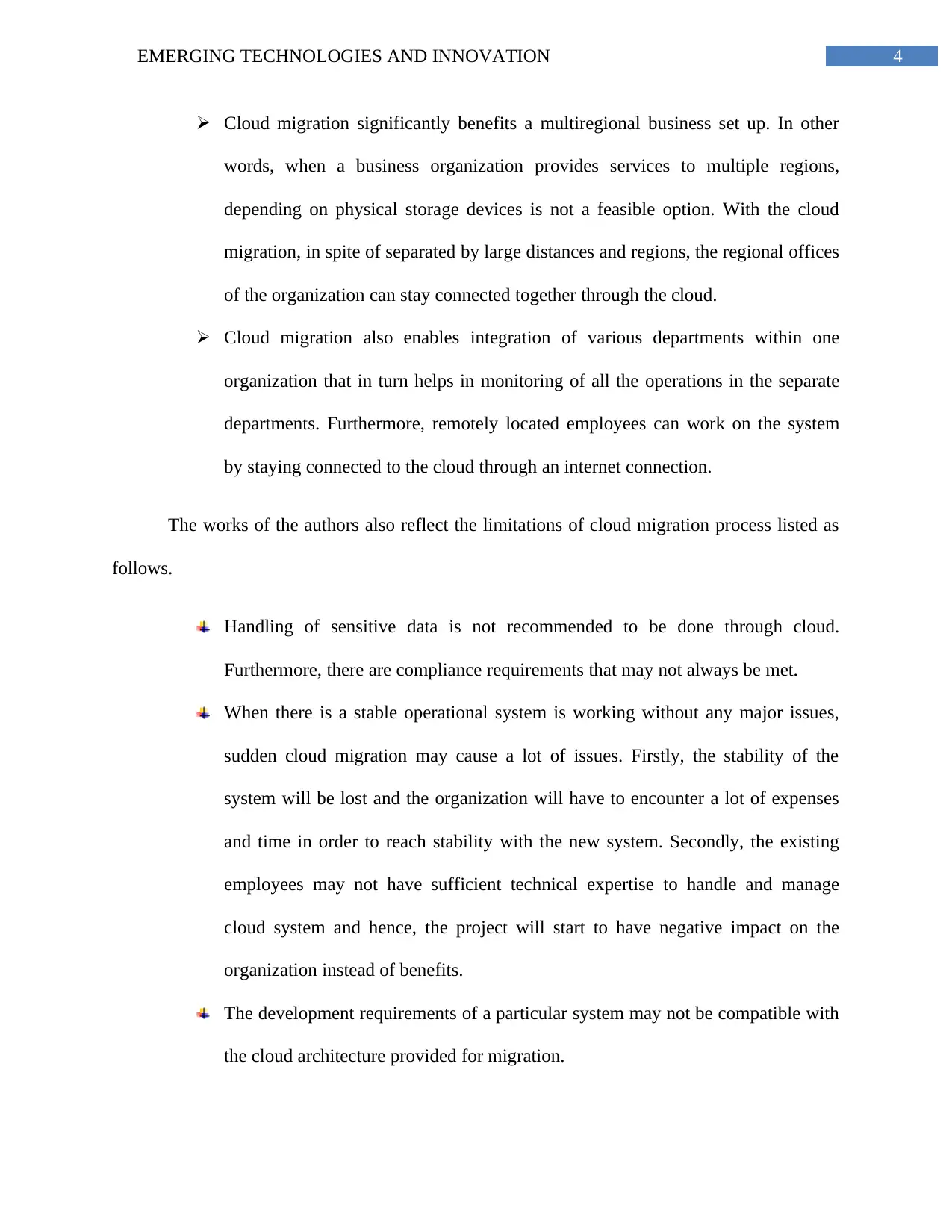
4EMERGING TECHNOLOGIES AND INNOVATION
Cloud migration significantly benefits a multiregional business set up. In other
words, when a business organization provides services to multiple regions,
depending on physical storage devices is not a feasible option. With the cloud
migration, in spite of separated by large distances and regions, the regional offices
of the organization can stay connected together through the cloud.
Cloud migration also enables integration of various departments within one
organization that in turn helps in monitoring of all the operations in the separate
departments. Furthermore, remotely located employees can work on the system
by staying connected to the cloud through an internet connection.
The works of the authors also reflect the limitations of cloud migration process listed as
follows.
Handling of sensitive data is not recommended to be done through cloud.
Furthermore, there are compliance requirements that may not always be met.
When there is a stable operational system is working without any major issues,
sudden cloud migration may cause a lot of issues. Firstly, the stability of the
system will be lost and the organization will have to encounter a lot of expenses
and time in order to reach stability with the new system. Secondly, the existing
employees may not have sufficient technical expertise to handle and manage
cloud system and hence, the project will start to have negative impact on the
organization instead of benefits.
The development requirements of a particular system may not be compatible with
the cloud architecture provided for migration.
Cloud migration significantly benefits a multiregional business set up. In other
words, when a business organization provides services to multiple regions,
depending on physical storage devices is not a feasible option. With the cloud
migration, in spite of separated by large distances and regions, the regional offices
of the organization can stay connected together through the cloud.
Cloud migration also enables integration of various departments within one
organization that in turn helps in monitoring of all the operations in the separate
departments. Furthermore, remotely located employees can work on the system
by staying connected to the cloud through an internet connection.
The works of the authors also reflect the limitations of cloud migration process listed as
follows.
Handling of sensitive data is not recommended to be done through cloud.
Furthermore, there are compliance requirements that may not always be met.
When there is a stable operational system is working without any major issues,
sudden cloud migration may cause a lot of issues. Firstly, the stability of the
system will be lost and the organization will have to encounter a lot of expenses
and time in order to reach stability with the new system. Secondly, the existing
employees may not have sufficient technical expertise to handle and manage
cloud system and hence, the project will start to have negative impact on the
organization instead of benefits.
The development requirements of a particular system may not be compatible with
the cloud architecture provided for migration.
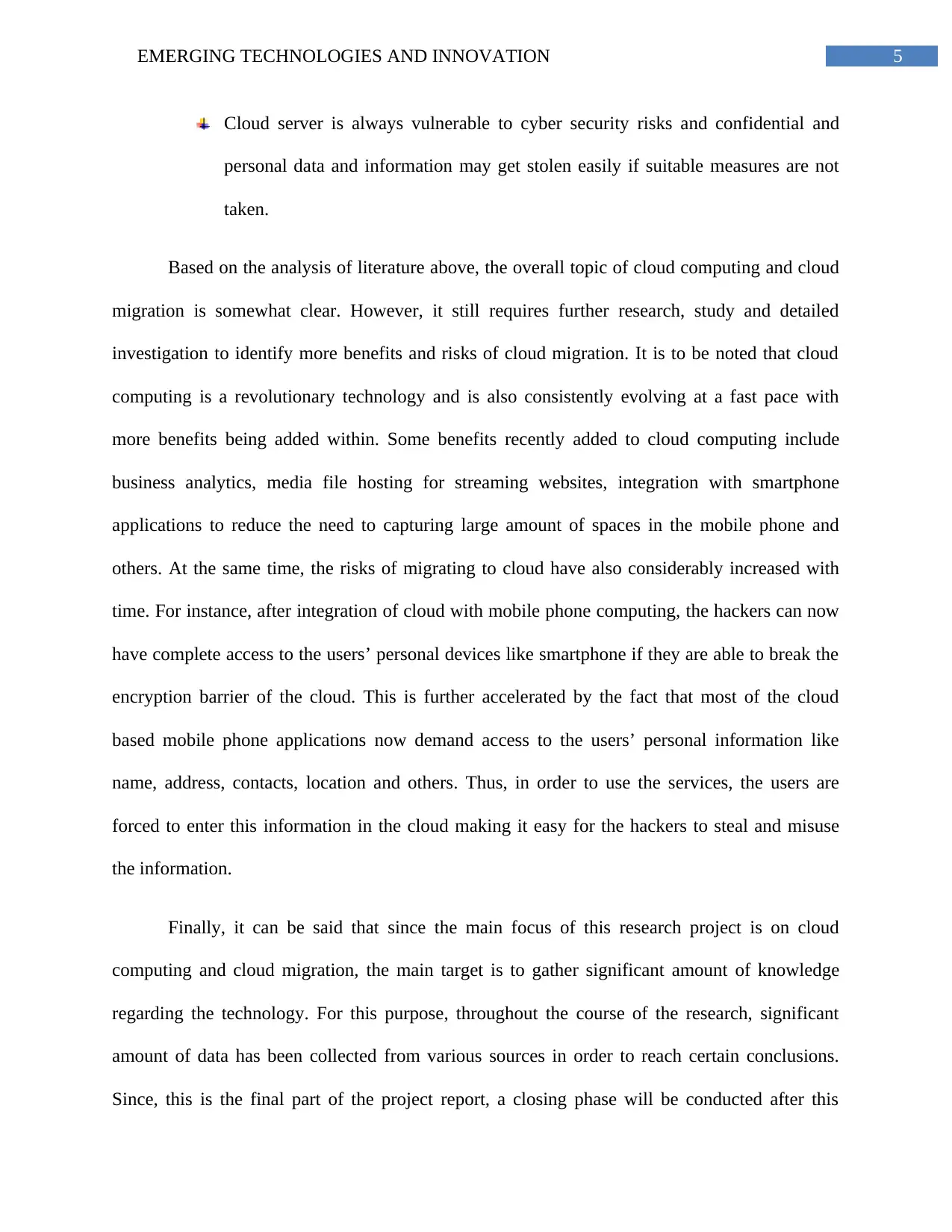
5EMERGING TECHNOLOGIES AND INNOVATION
Cloud server is always vulnerable to cyber security risks and confidential and
personal data and information may get stolen easily if suitable measures are not
taken.
Based on the analysis of literature above, the overall topic of cloud computing and cloud
migration is somewhat clear. However, it still requires further research, study and detailed
investigation to identify more benefits and risks of cloud migration. It is to be noted that cloud
computing is a revolutionary technology and is also consistently evolving at a fast pace with
more benefits being added within. Some benefits recently added to cloud computing include
business analytics, media file hosting for streaming websites, integration with smartphone
applications to reduce the need to capturing large amount of spaces in the mobile phone and
others. At the same time, the risks of migrating to cloud have also considerably increased with
time. For instance, after integration of cloud with mobile phone computing, the hackers can now
have complete access to the users’ personal devices like smartphone if they are able to break the
encryption barrier of the cloud. This is further accelerated by the fact that most of the cloud
based mobile phone applications now demand access to the users’ personal information like
name, address, contacts, location and others. Thus, in order to use the services, the users are
forced to enter this information in the cloud making it easy for the hackers to steal and misuse
the information.
Finally, it can be said that since the main focus of this research project is on cloud
computing and cloud migration, the main target is to gather significant amount of knowledge
regarding the technology. For this purpose, throughout the course of the research, significant
amount of data has been collected from various sources in order to reach certain conclusions.
Since, this is the final part of the project report, a closing phase will be conducted after this
Cloud server is always vulnerable to cyber security risks and confidential and
personal data and information may get stolen easily if suitable measures are not
taken.
Based on the analysis of literature above, the overall topic of cloud computing and cloud
migration is somewhat clear. However, it still requires further research, study and detailed
investigation to identify more benefits and risks of cloud migration. It is to be noted that cloud
computing is a revolutionary technology and is also consistently evolving at a fast pace with
more benefits being added within. Some benefits recently added to cloud computing include
business analytics, media file hosting for streaming websites, integration with smartphone
applications to reduce the need to capturing large amount of spaces in the mobile phone and
others. At the same time, the risks of migrating to cloud have also considerably increased with
time. For instance, after integration of cloud with mobile phone computing, the hackers can now
have complete access to the users’ personal devices like smartphone if they are able to break the
encryption barrier of the cloud. This is further accelerated by the fact that most of the cloud
based mobile phone applications now demand access to the users’ personal information like
name, address, contacts, location and others. Thus, in order to use the services, the users are
forced to enter this information in the cloud making it easy for the hackers to steal and misuse
the information.
Finally, it can be said that since the main focus of this research project is on cloud
computing and cloud migration, the main target is to gather significant amount of knowledge
regarding the technology. For this purpose, throughout the course of the research, significant
amount of data has been collected from various sources in order to reach certain conclusions.
Since, this is the final part of the project report, a closing phase will be conducted after this
⊘ This is a preview!⊘
Do you want full access?
Subscribe today to unlock all pages.

Trusted by 1+ million students worldwide
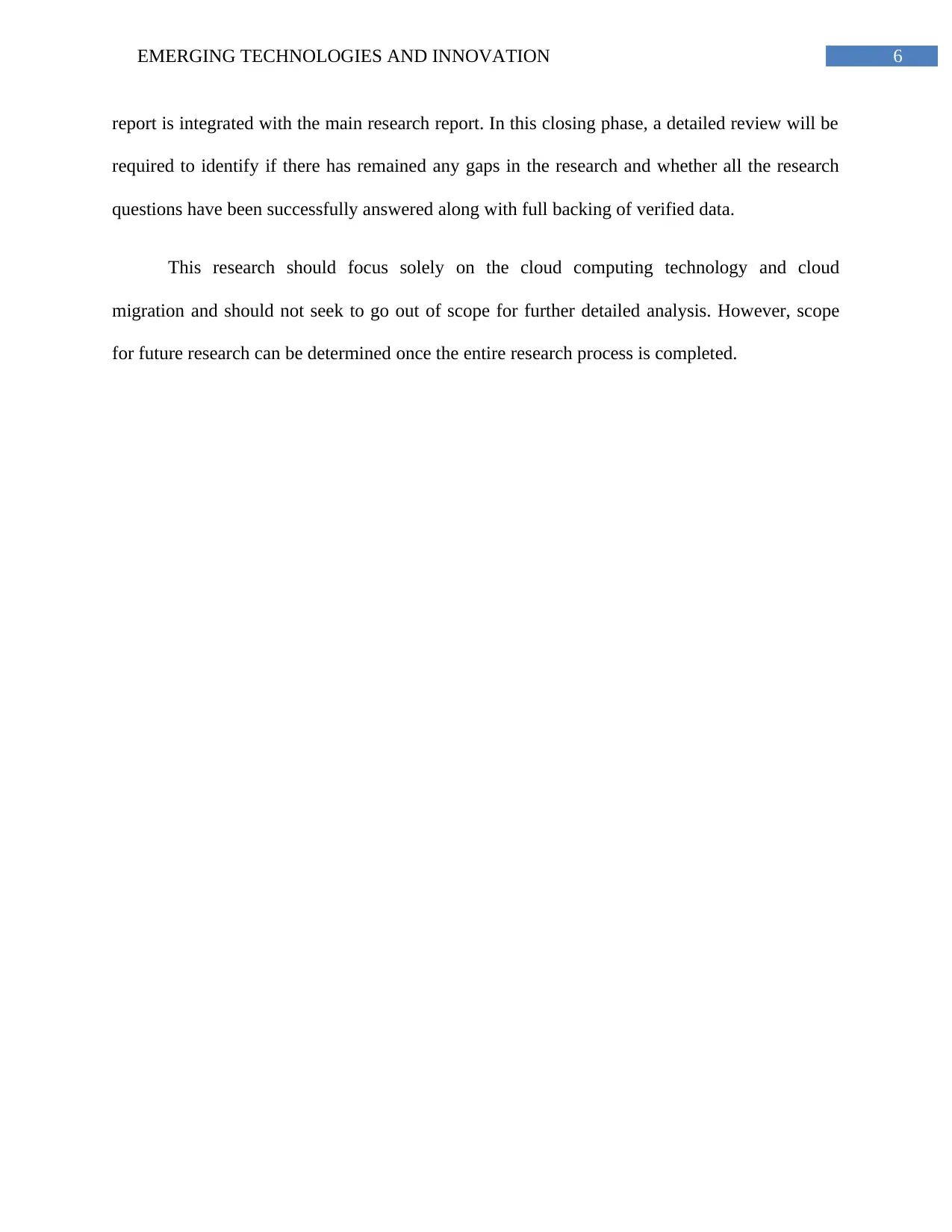
6EMERGING TECHNOLOGIES AND INNOVATION
report is integrated with the main research report. In this closing phase, a detailed review will be
required to identify if there has remained any gaps in the research and whether all the research
questions have been successfully answered along with full backing of verified data.
This research should focus solely on the cloud computing technology and cloud
migration and should not seek to go out of scope for further detailed analysis. However, scope
for future research can be determined once the entire research process is completed.
report is integrated with the main research report. In this closing phase, a detailed review will be
required to identify if there has remained any gaps in the research and whether all the research
questions have been successfully answered along with full backing of verified data.
This research should focus solely on the cloud computing technology and cloud
migration and should not seek to go out of scope for further detailed analysis. However, scope
for future research can be determined once the entire research process is completed.
Paraphrase This Document
Need a fresh take? Get an instant paraphrase of this document with our AI Paraphraser
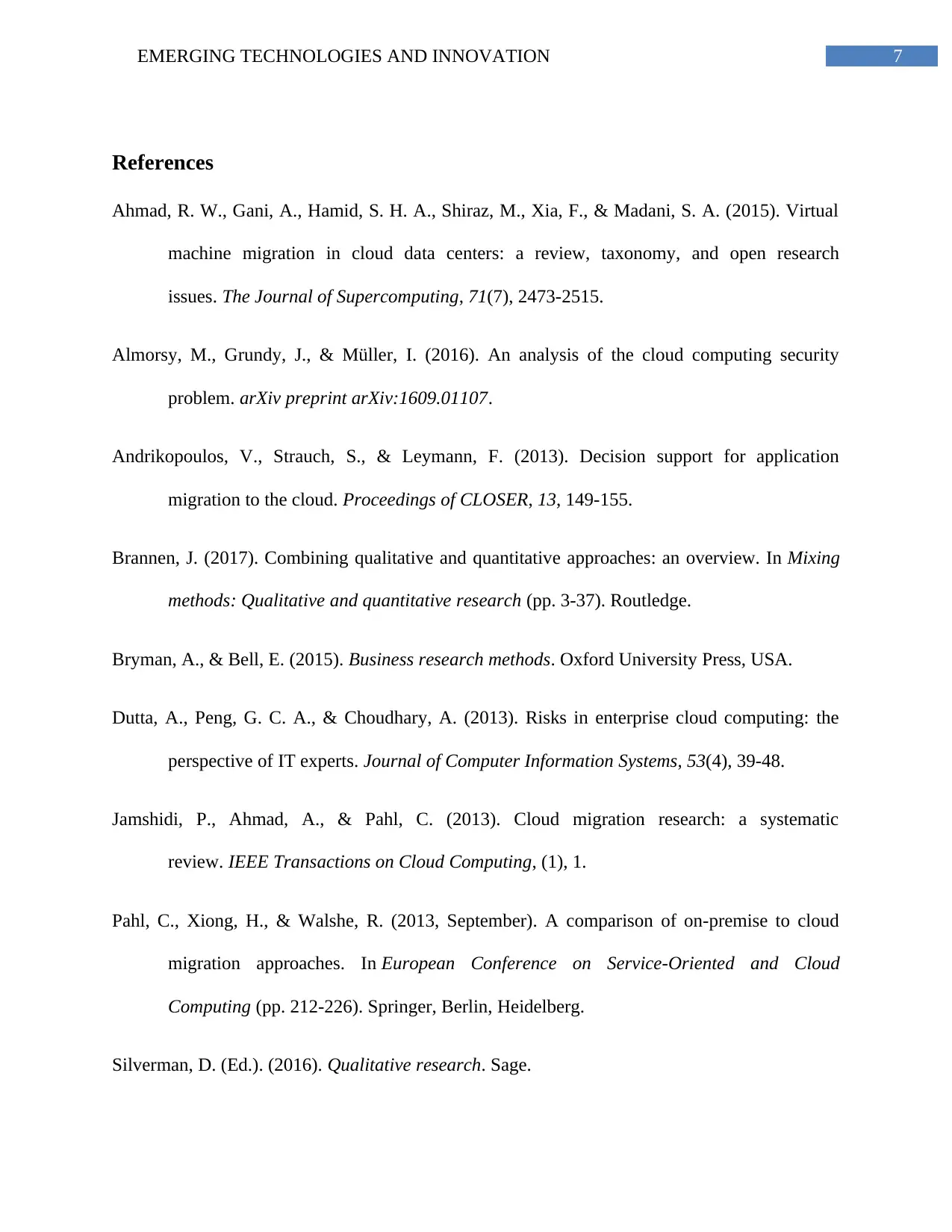
7EMERGING TECHNOLOGIES AND INNOVATION
References
Ahmad, R. W., Gani, A., Hamid, S. H. A., Shiraz, M., Xia, F., & Madani, S. A. (2015). Virtual
machine migration in cloud data centers: a review, taxonomy, and open research
issues. The Journal of Supercomputing, 71(7), 2473-2515.
Almorsy, M., Grundy, J., & Müller, I. (2016). An analysis of the cloud computing security
problem. arXiv preprint arXiv:1609.01107.
Andrikopoulos, V., Strauch, S., & Leymann, F. (2013). Decision support for application
migration to the cloud. Proceedings of CLOSER, 13, 149-155.
Brannen, J. (2017). Combining qualitative and quantitative approaches: an overview. In Mixing
methods: Qualitative and quantitative research (pp. 3-37). Routledge.
Bryman, A., & Bell, E. (2015). Business research methods. Oxford University Press, USA.
Dutta, A., Peng, G. C. A., & Choudhary, A. (2013). Risks in enterprise cloud computing: the
perspective of IT experts. Journal of Computer Information Systems, 53(4), 39-48.
Jamshidi, P., Ahmad, A., & Pahl, C. (2013). Cloud migration research: a systematic
review. IEEE Transactions on Cloud Computing, (1), 1.
Pahl, C., Xiong, H., & Walshe, R. (2013, September). A comparison of on-premise to cloud
migration approaches. In European Conference on Service-Oriented and Cloud
Computing (pp. 212-226). Springer, Berlin, Heidelberg.
Silverman, D. (Ed.). (2016). Qualitative research. Sage.
References
Ahmad, R. W., Gani, A., Hamid, S. H. A., Shiraz, M., Xia, F., & Madani, S. A. (2015). Virtual
machine migration in cloud data centers: a review, taxonomy, and open research
issues. The Journal of Supercomputing, 71(7), 2473-2515.
Almorsy, M., Grundy, J., & Müller, I. (2016). An analysis of the cloud computing security
problem. arXiv preprint arXiv:1609.01107.
Andrikopoulos, V., Strauch, S., & Leymann, F. (2013). Decision support for application
migration to the cloud. Proceedings of CLOSER, 13, 149-155.
Brannen, J. (2017). Combining qualitative and quantitative approaches: an overview. In Mixing
methods: Qualitative and quantitative research (pp. 3-37). Routledge.
Bryman, A., & Bell, E. (2015). Business research methods. Oxford University Press, USA.
Dutta, A., Peng, G. C. A., & Choudhary, A. (2013). Risks in enterprise cloud computing: the
perspective of IT experts. Journal of Computer Information Systems, 53(4), 39-48.
Jamshidi, P., Ahmad, A., & Pahl, C. (2013). Cloud migration research: a systematic
review. IEEE Transactions on Cloud Computing, (1), 1.
Pahl, C., Xiong, H., & Walshe, R. (2013, September). A comparison of on-premise to cloud
migration approaches. In European Conference on Service-Oriented and Cloud
Computing (pp. 212-226). Springer, Berlin, Heidelberg.
Silverman, D. (Ed.). (2016). Qualitative research. Sage.
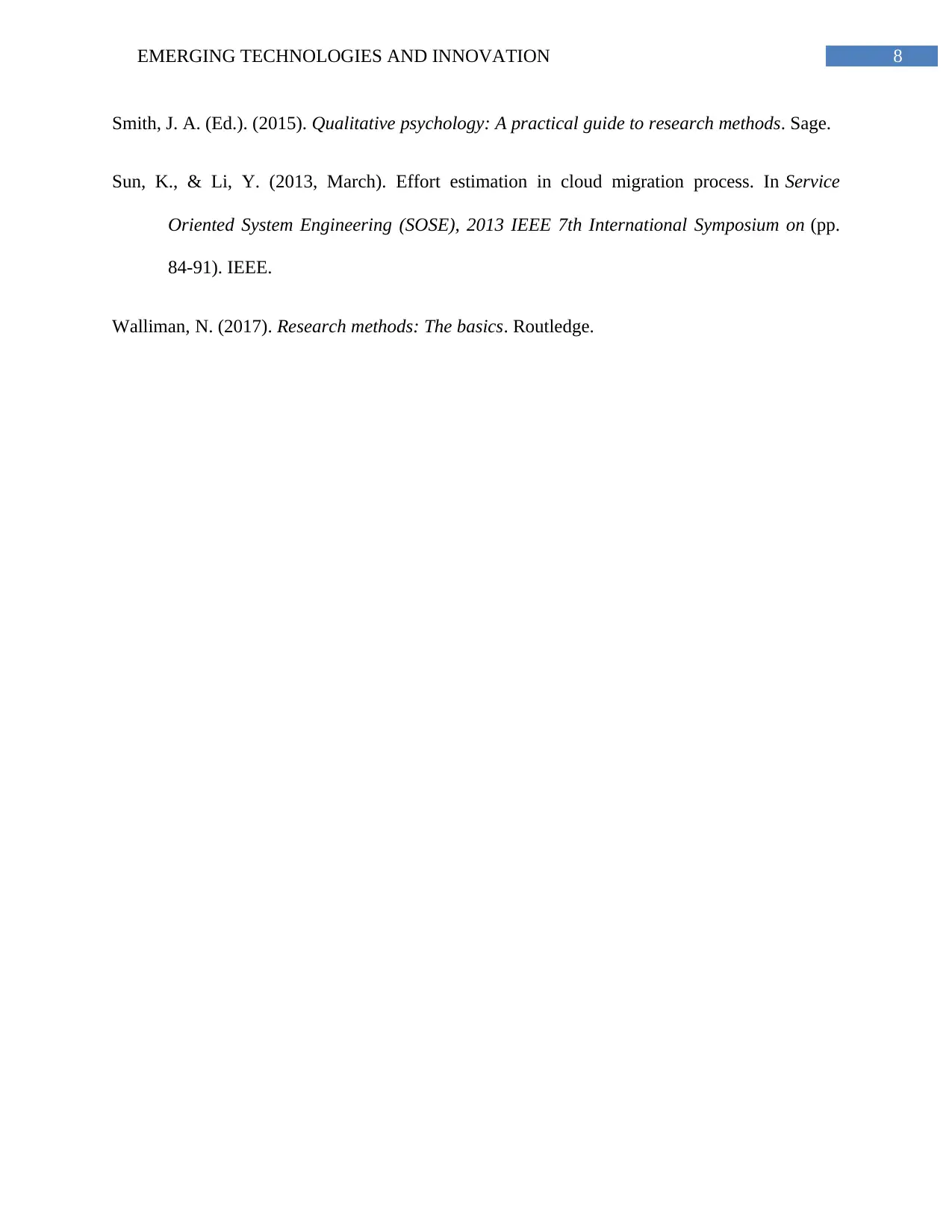
8EMERGING TECHNOLOGIES AND INNOVATION
Smith, J. A. (Ed.). (2015). Qualitative psychology: A practical guide to research methods. Sage.
Sun, K., & Li, Y. (2013, March). Effort estimation in cloud migration process. In Service
Oriented System Engineering (SOSE), 2013 IEEE 7th International Symposium on (pp.
84-91). IEEE.
Walliman, N. (2017). Research methods: The basics. Routledge.
Smith, J. A. (Ed.). (2015). Qualitative psychology: A practical guide to research methods. Sage.
Sun, K., & Li, Y. (2013, March). Effort estimation in cloud migration process. In Service
Oriented System Engineering (SOSE), 2013 IEEE 7th International Symposium on (pp.
84-91). IEEE.
Walliman, N. (2017). Research methods: The basics. Routledge.
⊘ This is a preview!⊘
Do you want full access?
Subscribe today to unlock all pages.

Trusted by 1+ million students worldwide
1 out of 9
Related Documents
Your All-in-One AI-Powered Toolkit for Academic Success.
+13062052269
info@desklib.com
Available 24*7 on WhatsApp / Email
![[object Object]](/_next/static/media/star-bottom.7253800d.svg)
Unlock your academic potential
Copyright © 2020–2025 A2Z Services. All Rights Reserved. Developed and managed by ZUCOL.




